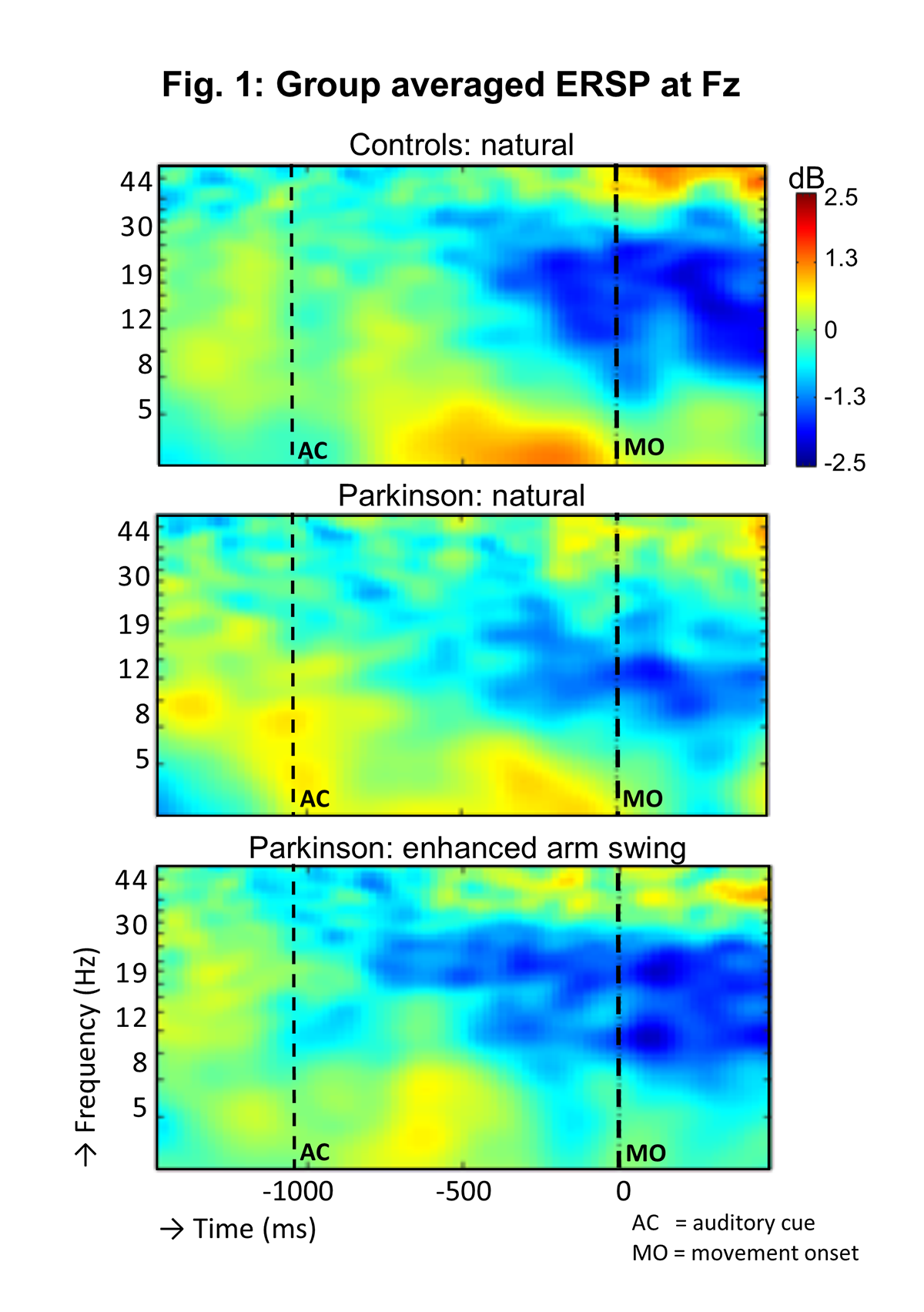Session Information
Date: Tuesday, September 24, 2019
Session Title: Parkinsonisms and Parkinson-Plus
Session Time: 1:45pm-3:15pm
Location: Agora 3 West, Level 3
Objective: Objective: To examine the effect of enhanced arm swing when starting to walk on gait initiation and related brain activity in patients with Parkinson’s disease (PD).
Background: Background: Difficulty in gait initiation commonly occurs in PD, which may benefit from external or internal cues [1]. Arm swing movements, which are impaired in PD patients, have been shown to be beneficial for human gait [2]. Arm swing movements may therefore serve as an internal cue in PD patients experiencing difficulty initiating gait.
Method: Methods: Ambulant electroencephalography (EEG), electromyography (EMG) and inertial measurement units (IMU) were employed during gait initiation in 19 healthy participants and 17 PD patients with self-reported trouble initiating gait. Following an auditory beep, all participants initiated gait 30 times without further instructions, while PD patients additionally initiated gait 30 times with the cue requiring enhanced arm swing. Power changes across the EEG frequency spectrum were assessed by Event Related Spectral Perturbation (ERSP) analysis in electrodes over the putative Supplementary motor area (SMA) at electrode position Fz and additional sensorimotor regions.
Results: Results: PD patients initiating gait without arm swing instructions showed enhanced alpha/theta event related synchronization (ERS) around time of auditory cue (p=0.018), reduced beta event related desynchronization (ERD) prior to movement onset (p=0.009) and reduced alpha/beta ERD over the putative SMA after movement onset (p=0.013) compared to controls [figure1]. When PD patients initiated gait with enhanced arm swing these group differences disappeared, leaving similar ERSP in patients and controls. Beta ERD prior to movement onset was earlier in PD patients with enhanced arm swing compared to natural start in both patients and controls. Additionally, EMG and IMU analyses showed more efficient gait initiation when PD patients started walking with enhanced arm swing compared to without arm instructions.
Conclusion: Conclusions: Initiating gait with preparing enhanced arm swing results in beneficial power changes across the EEG frequency spectrum leading to more efficient gait initiation in PD patients, indicating that the task serves as an internal cue to overcome gait initiation difficulties.
References: [1] Peterson DS, Smulders K. Cues and Attention in Parkinsonian Gait: Potential Mechanisms and Future Directions. Front Neurol. 2015;6:255. [2] Bondi M, Zeilig G, Bloch A, Fasano A, Plotnik M. Split-arm swinging: the effect of arm swinging manipulation on interlimb coordination during walking. J Neurophysiol. 2017;118(2):1021-1033.
To cite this abstract in AMA style:
J. Weersink, N. Maurits, B. de Jong. Preparing enhanced arm swing facilitates gait initiation in Parkinson’s disease: a combined EEG-EMG-IMU study [abstract]. Mov Disord. 2019; 34 (suppl 2). https://www.mdsabstracts.org/abstract/preparing-enhanced-arm-swing-facilitates-gait-initiation-in-parkinsons-disease-a-combined-eeg-emg-imu-study/. Accessed April 2, 2025.« Back to 2019 International Congress
MDS Abstracts - https://www.mdsabstracts.org/abstract/preparing-enhanced-arm-swing-facilitates-gait-initiation-in-parkinsons-disease-a-combined-eeg-emg-imu-study/

